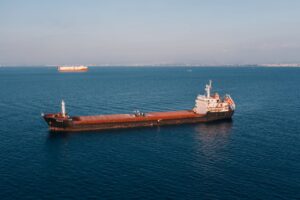The Automated Manifest System (AMS), initiated by U.S. Customs and Border Protection (CBP) in 2004, was specifically designed to enhance national security and streamline the processing of imports. By enabling the electronic transmission of shipment data before cargo arrives at U.S. borders, AMS plays a pivotal role in pre-assessing potential security risks and facilitating smoother trade operations.
This system was developed in response to the growing need for more rigorous security measures and faster processing of increasing international trade volumes.
What is AMS Filing?
AMS Filing is a crucial electronic system that allows shipping carriers to report cargo details to CBP before their arrival in the U.S. This system improves security by enabling early identification of potential threats and facilitates quicker cargo clearance, thus enhancing the efficiency of international trade logistics. By digitizing the data submission process, AMS helps reduce paperwork, speeds up customs clearance, and minimizes the chances of shipment delays.
Who Needs to File AMS?
AMS filings at the export port are primarily required by Non-Vessel Operating Common Carriers (NVOCC) or freight forwarders. These parties play a critical role in ensuring that cargo information is reported accurately and promptly to U.S. Customs and Border Protection. Any inaccuracies in the given information are the responsibility of the freight forwarder. Furthermore, they may face severe fines of up to US$10,000.
| Mode of Transport | Carrier | Considerations |
|---|---|---|
| Sea Freight | NVOCC | NVOCCs file AMS to consolidate shipments from multiple shippers into container loads and manage issuing bills of lading. |
| Freight Forwarder | Freight Forwarders may be required to file AMS, particularly when they perform functions typically associated with the NVOCC. | |
| Air Freight | Indirect Air Carrier | IACs consolidate shipments from various shippers and tender them to a direct air carrier. They are responsible for filing the AMS for these consolidated shipments. |
| Freight Forwarder | Freight forwarders may take on the responsibility of filing the AMS if they are acting as an IAC or if the IAC has delegated this task to them. In some instances, they may also file the AMS when they have a direct contractual relationship with the airline and manage the shipment details. | |
| Rail & Road Freight | Rail Carrier/Trucking Company | The rail carrier or trucking company is primarily responsible for filing the AMS for cargo transported by rail. |
| Freight Forwarder | Freight forwarders may be involved in filing the AMS if they have a direct contractual relationship with the trucking company and are responsible for managing the shipment details. |
Differences: AMS vs ISF Filing
Importer Security Filing (ISF), commonly referred to as “10+2”, is a requirement for ocean freight introduced by U.S. Customs and Border Protection (CBP) to enhance maritime security. ISF mandates importers to provide advance data about the cargo being shipped to the U.S. at least 24 hours before loading onto the vessel.
While both AMS and ISF aim to secure and facilitate the import process, they serve different functions. AMS (Automated Manifest System) is used by carriers across all transport modes to report cargo details before arrival in the U.S., enhancing border security and customs efficiency. In contrast, ISF filing specifically targets ocean cargo and focuses on detailed importation chain data prior to loading.
For a detailed at-a-glance comparison of AMS and ISF, the table below outlines the key differences and specific requirements of each filing system.
AMS vs ISF Data Requirements
| Feature | Imported Security Filing (ISF) | Automated Manifest System (AMS) Filing |
| Focus | Security and risk assessment | Cargo movement and customs clearance |
| Timeline | 24 hours before loading cargo onto vessel | Before vessel leaves shipment port |
| Responsible Party | Importer of Record (or their customs broker/freight forwarder) | Carrier or Freight Forwarder |
| Filing Mode | Electronic | Electronic |
| Data Elements | 10 data elements:
|
|
| Legal Basis | Security and Accountability For Every Port Act (SAFE Port Act) | Trade Act of 2022 |
Benefits of AMS Filing
The Automated Manifest System (AMS) offers significant benefits for carriers, freight forwarders, and importers, enhancing overall efficiency and security in cargo handling.
- Enhanced Security: AMS helps identify potential security threats before cargo arrives, allowing for preemptive action and reducing risks associated with cargo handling.
- Faster Clearance Process: By providing customs with advance information, AMS enables faster processing and release of shipments at ports, minimizing delays and improving turnaround times.
- Reduced Paperwork and Errors: The digital nature of AMS filing reduces the paperwork burden and minimizes the risk of errors, which can delay shipment processing and increase costs.
- Compliance and Avoidance of Penalties: Proper AMS filing ensures compliance with U.S. customs regulations, helping avoid costly penalties and potential legal issues.
- Operational Efficiency: AMS streamlines the documentation process, making it easier for shippers to manage logistics and focus on other critical aspects of their operations.
AMS Filing Timeframe
In order to comply with U.S. Customs regulations, it is crucial for freight forwarders and carriers to adhere to the specific AMS filing timelines based on the mode of transport.
|
Mode of Transport |
Filing Timeframe |
|
Sea |
At least 24 hours before the cargo is loaded onto the vessel at the foreign port. |
|
Air |
At least 4 hours before arrival in the U.S., or at the time of departure for flights less than 4 hours. |
|
Rail |
At least 2 hours before the truck arrives at the U.S. border. |
|
Highway |
At least 1 hour before the truck arrives at the U.S. border. |
AMS Fees
An AMS fee is charged to cover the costs associated with U.S. Customs and Border Protection (CBP)’s processing of manifest filings. The amount of this fee typically depends on the mode of transport, the volume of cargo, and the complexity of the shipment details.
On average, AMS fees can range widely but are often influenced by these operational variables.
It’s best to consult with your freight forwarder or customs broker for an accurate estimate based on your specific shipment details.
Required Information for AMS Filing
Proper AMS filing requires meticulous preparation of specific documents and detailed information to ensure compliance and facilitate efficient processing by U.S. Customs. Below is a detailed list of the necessary paperwork and the key information that must be included in those documents.
| AMS Filing for Importers | AMS Filing for NVOCCs | |
|---|---|---|
| Bill of Lading (BOL) |
|
|
| Cargo Control Number (CCN) |
|
|
| Consignee and Shipper Details |
|
|
| Manifest Document |
|
|
| Commercial Invoice |
|
|
| Importer Security Filing (ISF) |
|
|
| Carrier Bond |
|
Ways to File AMS
Filing the Automated Manifest System (AMS) can be accomplished through several methods, each catering to the different needs and capabilities of the shipping party. Each method offers distinct advantages and can be selected based on the specific needs and capabilities of the shipping or logistics firm involved. For companies looking to streamline their operations and ensure compliance, choosing the right filing method is critical. Below are detailed explanations of the available filing options:
- DIrect Filing
- Method: Direct filing is done through the Automated Commercial Environment (ACE) Portal managed by U.S. Customs and Border Protection (CBP).
- Overview: This method allows carriers or their agents to submit required shipping data directly to CBP. It requires users to have access to the ACE Portal and a thorough understanding of the filing process.
- Suitability and Drawbacks: Ideal for larger companies with the capacity to manage their compliance requirements in-house. However, it may be complex and resource-intensive for smaller entities without dedicated compliance staff.
- With a Freight Forwarder or Customs Broker
- Support Role: Freight forwarders and customs brokers can facilitate AMS filing by handling the submission process on behalf of the shipper. They possess expertise in compliance and are typically well-versed in the requirements of cross-border shipments.
- Advantages: Utilizing these professionals can help ensure accuracy, reduce the risk of noncompliance, and alleviate the administrative burden on shippers.
- AMS Software Provider
- Using Third-party Software: Many shippers opt to use specialized AMS software provided by third-party vendors. This software often integrates with existing shipping and logistics systems to streamline the filing process.
- Benefits: Third-party AMS software can offer user-friendly interfaces, error checking, and direct submission capabilities. This can be a cost-effective and efficient solution, especially for companies without the infrastructure to file directly.
Tips for AMS Filing
Prepare Required Information
Revisit the necessary documentation and data needed for AMS filing. Ensure all required information, such as Bill of Lading, Cargo Control Number, and consignee details, are gathered beforehand to streamline the filing process.
Ensure Accurate Information
Accuracy is paramount in AMS filings. Verify all submitted information for accuracy and completeness to avoid delays. Make any necessary amendments before the cargo arrives at the U.S. port, adhering strictly to the specified timelines for modifications.
Monitor Filing Status
After submitting your AMS filing, actively monitor its status to ensure it has been accepted by customs. Stay vigilant for any notifications requiring additional information and be prepared to make swift corrections. Filing early is advantageous as it provides ample time to address any issues that may arise.
Streamline AMS Filing
CrimsonLogic’s ISF filing software enhances the AMS filing process through automated data entry and real-time error alerts. This technology not only speeds up the customs clearance process but also helps avoid potential fines by minimizing errors, ensuring smoother and faster compliance with U.S. customs regulations. Additionally, CrimsonLogic supports filing across multiple platforms, including ACE Air, ACE Ocean, and ACE Highway, accommodating the diverse needs of air, ocean, and highway transport modes respectively. For more details on how CrimsonLogic can assist in optimizing your AMS filings, visit their ISF solutions page.





